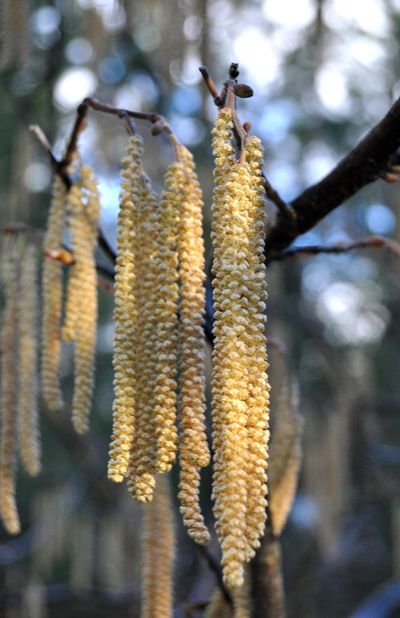Gardening: Early bloomers add color to seasonal transition

However, the showstoppers right now in my garden are the blooming witch hazel, hazelnuts and pussy willows. It is so good to see the first blooming plants begin to show their color. All three of these plants add great winter interest to an otherwise dull and dead garden.
Witch hazel is a small tree that can get to 15 feet tall and wide. It starts blooming in late February with four-petaled, bright yellow flowers that stick out of the branch in a somewhat spidery wild tangle. The blooms retract toward them at night and can take several days of temperatures in the low 20s. In the summer, the bold, oval leaves add texture to the garden and end the year in a blaze of yellow. The plants are native to Asia and North America, with the American one being fragrant. When English settlers first came to our eastern shores, they found American Indians using a forked branch of the tree to dowse or witch for water, hence the name. They need protection from deer.
Most of us are familiar with the hazelnuts or filberts we find in baked goods and candies. My hazelnut is a transplant we brought up from my husband’s family farm near Sweet Home, Oregon, and was blooming before the last of the snow melted in January. Oregon is the largest producer of filberts in the country. Hazelnuts usually grow as a multistemmed tree reaching 20 feet tall and wide. Their long-lasting, bright golden catkins light up in the winter sun for a couple of months. In the summer, the tree is covered with large oval, fuzzy leaves. If you want a good crop of nuts, you must plant two compatible varieties to get proper pollination. It takes three to five years to produce the first crop. That is, if you can beat the squirrels to them. Protect them from deer in the winter.
Finding and picking the first pussy willows has long been a rite of spring. Every year when I go to the Northwest Flower and Garden Show in Seattle in February, people are carrying around great bundles of branches covered with fuzzy white catkins. They are commonly found on both sides of the Cascades along moist stream banks and marshy shorelines.
If plowing through wet, muddy marsh land looking for the first pussy willows isn’t your thing, it makes a good shrubby landscape tree. They need ample water, full sun and should not be planted close to septic systems or sewer lines. Pussy willows can be started from cuttings from grown trees in the summer. Cut an 18-inch-long, pencil-sized branch from the current year’s growth and insert it into the soil halfway. Roots will grow from the underground section within a few weeks. They will need winter protection from browsing deer.
Pat Munts is the co-author of “Northwest Gardener’s Handbook” with Susan Mulvihill. Munts, a Master Gardener, has gardened in Spokane Valley for more than 35 years. She can be reached at pat@inland nwgardening.com.